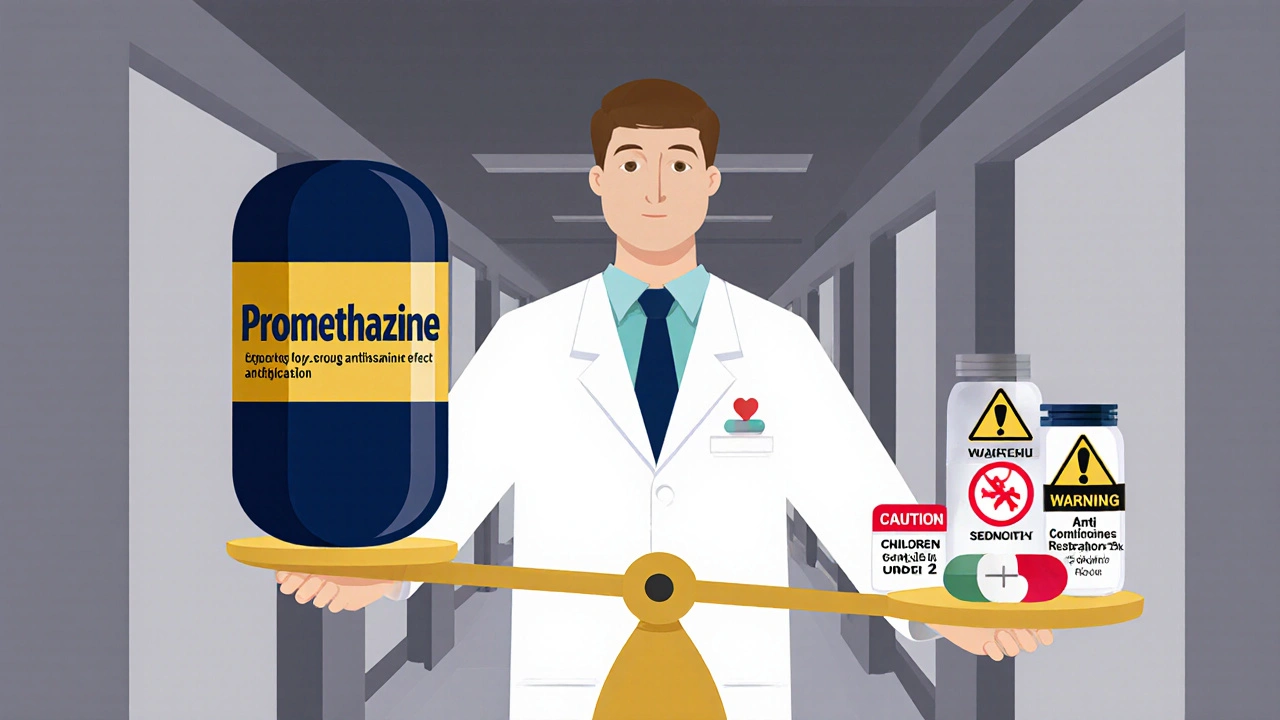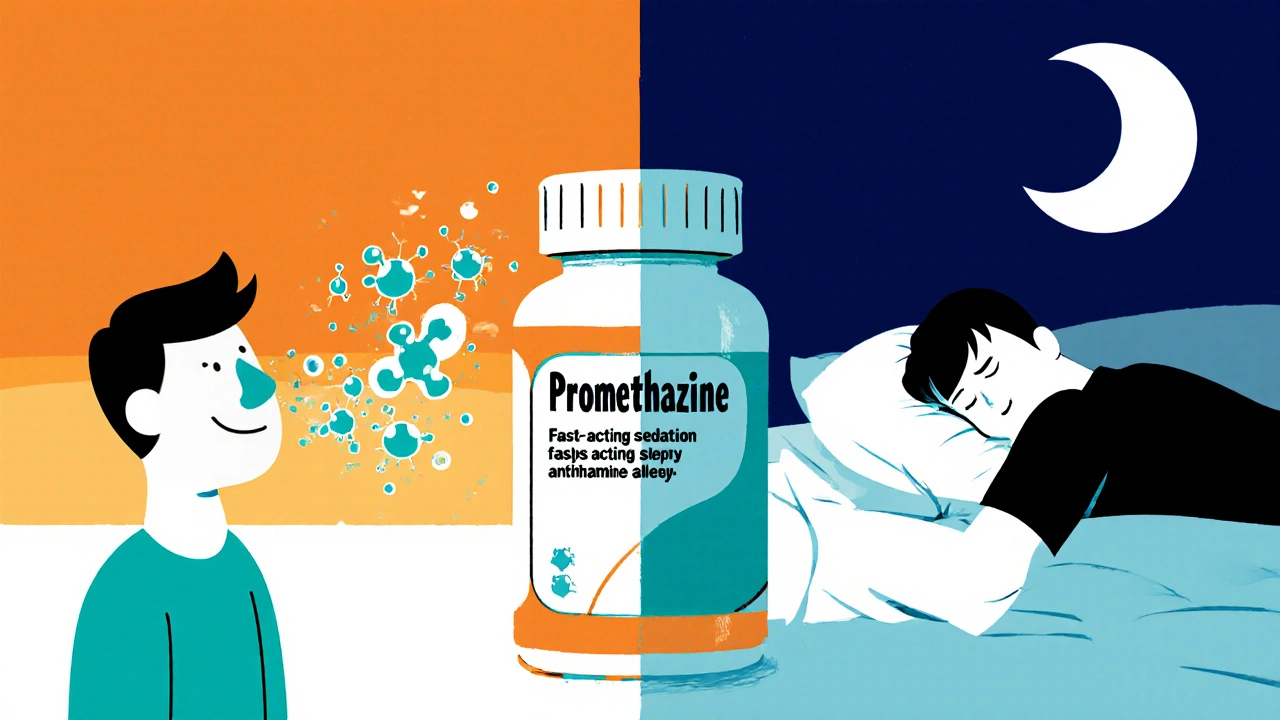Medication Comparison Tool
Find Your Best Medication
Select your symptoms and constraints to see which medication is most appropriate from the comparison in the article.
Your Recommendation
Why This Medication?
Effectiveness for Your Needs
Common Side Effects
When you need a fast‑acting antihistamine that also calms nausea or helps you sleep, Promethazine is often the go‑to drug. But it isn’t the only player on the shelf. In this guide we break down how Promethazine stacks up against other common antihistamines and anti‑emetics, so you can choose the right pill for your symptoms without the guesswork.
What Is Promethazine?
Promethazine is a first‑generation antihistamine that blocks H1 receptors, reducing the effects of histamine in the body. It also has strong anticholinergic and sedative properties, which is why doctors prescribe it for allergies, motion sickness, pre‑operative sedation, and as a short‑term sleep aid.
The drug works by crossing the blood‑brain barrier, a trait shared by many older antihistamines, giving it a noticeable calming effect. Its onset is usually within 30 minutes when taken orally, and the effects can last up to 12 hours, depending on the dose.
Key Attributes of Promethazine
- Formulations: tablets, syrup, injectable solution, rectal suppositories.
- Typical adult dose: 25‑50 mg every 4‑6 hours for allergic reactions; 12.5‑25 mg every 6‑8 hours for motion sickness.
- Metabolism: Liver (CYP2D6), with a half‑life of 10‑19 hours.
- Common side effects: Drowsiness, dry mouth, blurred vision, constipation.
- Serious risks: Respiratory depression in children, especially under 2 years; extrapyramidal symptoms with high doses.
Popular Alternatives to Promethazine
Below are the most frequently used alternatives. Each has a slightly different balance of sedation, anticholinergic activity, and anti‑nausea effectiveness.
Diphenhydramine (brand name Benadryl) is another first‑generation antihistamine that is widely available over‑the‑counter. It’s well‑known for its strong drowsy effect, making it a common nighttime sleep aid.
Hydroxyzine is a prescription antihistamine that’s often used for anxiety and itching. Its sedative qualities are milder than Promethazine, but it has a clearer safety profile for older adults.
Chlorpheniramine belongs to the same generation but is less sedating, so it’s a go‑to for daytime allergy relief.
Meclizine is primarily marketed for motion sickness and vertigo. It offers moderate sedation with a long duration (up to 24 hours).
Ondansetron is a serotonin 5‑HT3 antagonist, not an antihistamine, but it’s effective for chemotherapy‑induced nausea without causing drowsiness.
Dimenhydrinate (Dramamine) combines diphenhydramine with 8‑chlorotheophylline to reduce drowsiness while still treating motion sickness.
Head‑to‑Head Comparison
| Drug | Main Indications | Sedation Level | Anticholinergic | Onset | Duration | Typical Contra‑indications |
|---|---|---|---|---|---|---|
| Promethazine | Allergy, nausea, pre‑op sedation, insomnia | High | Strong | 30‑60 min | 8‑12 h | Children <2 y, severe CNS depression |
| Diphenhydramine (Benadryl) | Allergy, insomnia, motion sickness | High | Moderate | 15‑30 min | 4‑6 h | Glaucoma, urinary retention |
| Hydroxyzine | Anxiety, itching, mild sedation | Moderate | Moderate | 30‑45 min | 6‑8 h | Pregnancy (category D), severe CNS disease |
| Chlorpheniramine | Allergy, cold symptoms | Low‑Moderate | Low | 30‑60 min | 4‑6 h | Prostate hypertrophy, narrow-angle glaucoma |
| Meclizine | Motion sickness, vertigo | Low‑Moderate | Low | 1‑2 h | 24 h | Severe liver disease |
| Ondansetron | Chemotherapy‑induced nausea, post‑op nausea | None | None | 30‑60 min | 4‑6 h | Long QT syndrome, severe hepatic impairment |
| Dimenhydrinate (Dramamine) | Motion sickness | Moderate | Moderate | 15‑30 min | 4‑6 h | Glaucoma, severe asthma |
When to Choose Promethazine Over the Rest
If you need a combination of strong antihistamine action plus a reliable sedative effect, Promethazine often wins. It’s particularly useful for:
- Severe allergic reactions where rapid symptom control is critical.
- Patients who also require pre‑operative anxiety reduction.
- Children (over 2 y) with acute motion sickness, provided the dose is carefully measured.
For pure anti‑nausea without drowsiness, Ondansetron is a better fit. If you just want daytime allergy relief without feeling groggy, chlorpheniramine or a low‑dose second‑generation antihistamine (like cetirizine) would be preferable.
Safety Tips and Common Pitfalls
All first‑generation antihistamines share a risk of anticholinergic side effects-dry mouth, constipation, urinary retention, and blurred vision. Promethazine tops the list, so monitoring is essential for elderly patients who are prone to falls.
Never give Promethazine to infants under two years, as the FDA has warned about a potential fatal respiratory depression. Also avoid mixing with alcohol or other central nervous system depressants; the combined sedation can be dangerous.
Drug interactions to watch for include:
- Monoamine oxidase inhibitors (MAOIs): may increase sedation and hypotension.
- Other antihistamines: cumulative anticholinergic load.
- Opioids: heightened risk of respiratory depression.
Always inform your prescriber about over‑the‑counter cold medicines, which often contain supplemental antihistamines.

Practical Checklist for Switching or Starting Therapy
- Identify primary symptom (allergy vs nausea vs insomnia).
- Check patient age and any history of glaucoma, urinary issues, or heart rhythm problems.
- Review current meds for CNS depressants or MAOIs.
- Pick the drug with the lowest effective sedation level for daytime use.
- Monitor for 48‑72 hours after start; watch for excessive drowsiness, dry mouth, or confusion.
Frequently Asked Questions
Can I use Promethazine for a common cold?
It can relieve runny nose and sneezing, but the strong drowsiness makes it less ideal for daytime use. A non‑sedating antihistamine is usually better.
Is Promethazine safe during pregnancy?
It’s classified as Category C in the U.S., meaning risk cannot be ruled out. Discuss alternatives with your OB‑GYN before taking it.
How does Promethazine differ from Benadryl?
Both are first‑generation antihistamines, but Promethazine has stronger anticholinergic effects and a longer half‑life, making it more sedating and better for nausea.
Can I combine Promethazine with a sleep aid?
Combining two sedatives can cause excessive sleepiness or respiratory depression. Only do so under direct medical supervision.
What is the best over‑the‑counter alternative for motion sickness?
For most travelers, meclizine or dimenhydrinate works well with less grogginess than Promethazine. Choose based on how long you need coverage.
Bottom Line
Promethazine remains a powerful, multi‑purpose drug, but its heavy sedation and anticholinergic load mean it’s not the first pick for every situation. By weighing the specific symptom, patient profile, and safety considerations, you can decide whether Promethazine or one of its less drowsy cousins is the smarter choice.







Edward Brown
October 25, 2025 AT 18:00When you swallow a pill you are not just treating a symptom you are signing a contract with a shadowy pharma oligarchy that profits from our discomfort. Promethazine looks like a simple antihistamine but its ability to cross the blood brain barrier is a double edged sword that the regulators chose to ignore. The sedation it gives is not just a side effect it is a feature designed to keep us compliant. If you read the fine print you will see that the same mechanisms are used in older mind‑control experiments. Think twice before you let a company decide when you can be awake.
ALBERT HENDERSHOT JR.
October 26, 2025 AT 02:53Thank you for bringing up the broader context; it's essential to remember that drug choices also involve clinical evidence and individualized needs. While the concerns you raised are thought‑provoking, many physicians weigh the benefits of rapid antihistamine action against potential risks on a case‑by‑case basis. Promethazine does have a strong sedative profile, but for patients suffering from severe motion sickness or pre‑operative anxiety it can be life‑changing. I encourage you to discuss both the pharmacology and the practical outcomes with your healthcare provider to find the best fit for your situation :)
Suzanne Carawan
October 26, 2025 AT 13:00Oh great, another bedtime story about how all antihistamines are secretly part of a grand illusion.
Kala Rani
October 26, 2025 AT 15:46They call it a "grand illusion" but the real magic is how a cheap over‑the‑counter syrup can put you out for hours while you think you’re treating a cold. The industry loves that narrative because it sells more product in the morning when you’re groggy. If you actually read the studies you’ll see that many of these drugs have comparable efficacy with far fewer side effects. So maybe the illusion isn’t the drugs but the hype around them.
Donal Hinely
October 27, 2025 AT 00:06Listen up folks, if you’re chasing the high‑octane kick of Promethazine you’re missing the whole buffet of flavors the pharmacopeia has to offer. Diphenhydramine slaps you with a drowsy punch that feels like a warm blanket on a cold night, while Hydroxyzine quietly sneaks in, calming anxiety without turning you into a zombie. Chlorpheniramine is the crisp, no‑nonsense daytime defender that lets you keep your eyes open for that marathon meeting. And let’s not forget Meclizine, the long‑lasting cruise‑control for vertigo that won’t yank you out of bed at 3 AM. Pick your poison wisely, because each one carries its own party tricks and hangovers.
christine badilla
October 27, 2025 AT 08:26Wow, you just turned a simple drug comparison into an epic saga and I am here for the drama! I’ve been riding the Promethazine rollercoaster for years and let me tell you, the “high‑octane kick” feels like being on a carnival ride that never stops. One minute I’m drifting off in a cloud of cotton candy, the next I’m jolted awake by my own thoughts screaming for attention. The side effects are like unwanted guests at a party – dry mouth, blurry vision, and that ever‑present constipation that refuses to leave. But when the nausea hits and nothing else works, I’m glad I have that trusty bottle waiting in the nightstand. 😭
Octavia Clahar
October 27, 2025 AT 16:46While the excitement around these antihistamines is understandable, it’s important to keep a balanced perspective. Not every drug suits every person, and the “one size fits all” mindset can lead to unnecessary side effects. For instance, elderly patients often benefit more from Hydroxyzine due to its milder anticholinergic load. On the other hand, younger individuals who need rapid sedation might find Promethazine’s potency advantageous. Ultimately, the best choice hinges on individual health status, concurrent meds, and specific symptom goals.
Sunita Basnet
October 27, 2025 AT 22:20Great points! Leveraging a patient‑centric framework and evaluating the pharmacodynamic profile can streamline therapeutic decision‑making. Integrating real‑world evidence with clinical guidelines maximizes outcome efficacy while minimizing adverse event risk. Keep the conversation going and empower folks to own their medication journey.
Justin Scherer
October 28, 2025 AT 12:13Promethazine is a first‑generation antihistamine that works fast and often makes people sleepy. It can help with allergies, motion sickness, and can be used before surgery to calm patients. The drug gets into the brain quickly, which is why the drowsiness is so strong. Most people feel the effects within half an hour and they can last up to twelve hours. Common side effects include dry mouth, blurred vision, and constipation. In children under two years the drug can cause serious breathing problems, so doctors avoid giving it to them. There are several other options that doctors can choose instead of Promethazine. Diphenhydramine, known as Benadryl, is also a first‑generation antihistamine with a similar sleepy effect. Hydroxyzine is a prescription drug that is less sedating and is sometimes used for anxiety. Chlorpheniramine is milder on the brain and works well during the day for allergy relief. Meclizine is especially good for motion sickness and can last a whole day. Ondansetron works in a completely different way, blocking serotonin, and it does not make you drowsy. Dimenhydrinate mixes diphenhydramine with a stimulant to lessen the sleepy feeling while still treating motion sickness. When comparing these drugs you need to look at how strong the sedation is, how long the drug lasts, and any special warnings for certain patients. For older adults, a drug with lower anticholinergic activity like Hydroxyzine might be safer. For someone who needs a strong night‑time aid, Promethazine or Diphenhydramine could be the right choice.